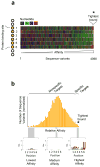Specificity and nonspecificity in RNA-protein interactions
- PMID: 26285679
- PMCID: PMC4744649
- DOI: 10.1038/nrm4032
Specificity and nonspecificity in RNA-protein interactions
Abstract
To fully understand the regulation of gene expression, it is critical to quantitatively define whether and how RNA-binding proteins (RBPs) discriminate between alternative binding sites in RNAs. Here, we describe new methods that measure protein binding to large numbers of RNA variants, and ways to analyse and interpret data obtained by these approaches, including affinity distributions and free energy landscapes. We discuss how the new methodologies and the associated concepts enable the development of inclusive, quantitative models for RNA-protein interactions that transcend the traditional binary classification of RBPs as either specific or nonspecific.
Figures




Similar articles
-
Mapping specificity landscapes of RNA-protein interactions by high throughput sequencing.Methods. 2017 Apr 15;118-119:111-118. doi: 10.1016/j.ymeth.2017.03.002. Epub 2017 Mar 2. Methods. 2017. PMID: 28263887 Free PMC article.
-
RNA Bind-n-Seq: Measuring the Binding Affinity Landscape of RNA-Binding Proteins.Methods Enzymol. 2015;558:465-493. doi: 10.1016/bs.mie.2015.02.007. Epub 2015 May 12. Methods Enzymol. 2015. PMID: 26068750 Free PMC article.
-
A knowledge-based potential function predicts the specificity and relative binding energy of RNA-binding proteins.FEBS J. 2007 Dec;274(24):6378-91. doi: 10.1111/j.1742-4658.2007.06155.x. Epub 2007 Nov 12. FEBS J. 2007. PMID: 18005254
-
Deciphering the protein-RNA recognition code: combining large-scale quantitative methods with structural biology.Bioessays. 2015 Aug;37(8):899-908. doi: 10.1002/bies.201500033. Epub 2015 Jun 8. Bioessays. 2015. PMID: 26059946 Review.
-
RNA-protein interactions: an overview.Methods Mol Biol. 2014;1097:491-521. doi: 10.1007/978-1-62703-709-9_23. Methods Mol Biol. 2014. PMID: 24639174 Review.
Cited by
-
In silico and in vitro analysis of the impact of single substitutions within EXO-motifs on Hsa-MiR-1246 intercellular transfer in breast cancer cell.J Appl Genet. 2023 Feb;64(1):105-124. doi: 10.1007/s13353-022-00730-y. Epub 2022 Nov 17. J Appl Genet. 2023. PMID: 36394782 Free PMC article.
-
Bayesian Markov models consistently outperform PWMs at predicting motifs in nucleotide sequences.Nucleic Acids Res. 2016 Jul 27;44(13):6055-69. doi: 10.1093/nar/gkw521. Epub 2016 Jun 9. Nucleic Acids Res. 2016. PMID: 27288444 Free PMC article.
-
UV crosslinked mRNA-binding proteins captured from leaf mesophyll protoplasts.Plant Methods. 2016 Nov 3;12:42. doi: 10.1186/s13007-016-0142-6. eCollection 2016. Plant Methods. 2016. PMID: 27822292 Free PMC article.
-
A Genetically Encoded Diazirine Analogue for RNA-Protein Photo-crosslinking.Chembiochem. 2020 Jan 15;21(1-2):88-93. doi: 10.1002/cbic.201900559. Epub 2019 Nov 26. Chembiochem. 2020. PMID: 31658407 Free PMC article.
-
SR Proteins: Binders, Regulators, and Connectors of RNA.Mol Cells. 2017 Jan;40(1):1-9. doi: 10.14348/molcells.2017.2319. Epub 2017 Jan 26. Mol Cells. 2017. PMID: 28152302 Free PMC article. Review.
References
Publication types
MeSH terms
Substances
Grants and funding
LinkOut - more resources
Full Text Sources
Other Literature Sources

